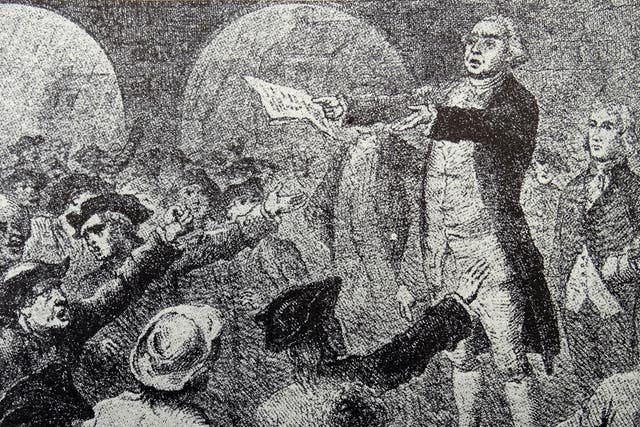

Committees of correspondence were emergency provisional governments set up in the 13 American colonies in response to British policies leading up to the Revolutionary War (also known as the American Revolution). The exchange of ideas, information and debate between different committees of correspondence helped organize and mobilize patriotic resistance in communities throughout the colonies and built the foundations for the Continental Congress.
Up until the late 18th century, Britain’s American colonies enjoyed a high level of autonomy and control over their own political and economic affairs, thanks to the long-standing unofficial policy known as salutary neglect. This began to change soon after the French and Indian War when King George III and his ministers set out to strengthen Britain’s hold on the colonies (and raise revenue to pay the British war debt).
Tensions began rising in 1764 with the British Parliament’s passage of the Sugar Act, which imposed a duty on sugar and molasses imported into the colonies. This was followed swiftly by the Currency Act, which prohibited the colonies from printing their own currency; and the Stamp Act, which required colonists to pay a tax on paper and printed materials.
During the 1760s, Boston, New York and other colonies established committees of correspondence to organize resistance to such unpopular legislation. These early committees of correspondence were assumed to be temporary structures that would be dissolved as soon as a particular policy was rescinded. They proved effective in mobilizing opposition to British policies: By 1770 Britain had repealed the Stamp Act and most of the Townshend Acts, a series of measures that taxed goods like china, glass, lead, paint, paper and tea.
In November 1772, Samuel Adams and other leading patriots formed the Boston Committee of Correspondence in response to the news that governors, judges and other high officials in Massachusetts Bay Province would be paid their salaries by the Crown, rather than by colonial legislatures. Adams argued that this threatened colonists’ right to fair trials, as the judges were responsible to the British king instead of local institutions. After the Boston committee wrote a list of grievances against the British government and distributed it widely, committees of correspondence began forming in towns throughout Massachusetts and beyond.
Growing patriotic discontent in Boston erupted into the Boston Tea Party in December 1773, and British reprisals—including passage of the Coercive Acts (known in the colonies as the Intolerable Acts) in the spring of 1774—would only fan the flames of colonial resistance. Instead of isolating Massachusetts and preventing unified resistance to British policies, the Intolerable Acts instead served to rally more support behind the growing Patriot cause.
The measure that imposed a tax on all printed materials inspired widespread outrage and even violence among the colonists.
The 13 British colonies eventually joined to form the United States—but as colonies, they were often more different than they were alike.
Britain and the Imperial Crises Throughout most of colonial history, the British Crown was the only political institution that united the American colonies. The Imperial Crises of the 1760s and 1770s, found England saddled with crippling debt, incurred in large part by wars such as the French and Indian War. The British government responded by […]
Meanwhile, the fallout continued from the Gaspee Affair, which involved a group of Rhode Islanders who burned a British customs ship in June 1772. Parliament had ordered a commission to investigate the ship’s burning and send the perpetrators back to England to trial. Viewing this as an alarming act of imperialism, the Virginia House of Burgesses formed its own committee of correspondence in March 1773 to open up communication and organize resistance among the colonies.
By the end of 1774, networks of committees of correspondence had been established in 11 of the 13 colonies, excluding Pennsylvania and North Carolina, with an estimated total membership of around 7,000 people.
The committees of correspondence functioned mainly as a means of spreading news and information about the Patriot cause and mobilizing opposition to British policies in cities, towns and rural communities throughout the colonies. Many members were also affiliated with local chapters of the Sons of Liberty, the secret military and political organization that had been instrumental in carrying out the Boston Tea Party.
In the year leading up to the Revolutionary War, committees of correspondence provided the structure for choosing delegates to represent each colony at the First Continental Congress, which convened in Philadelphia in September 1774 to demand an end to British repression of colonial liberties. Local committees of correspondence throughout the colonies later collaborated with committees of safety, which were empowered to organize, train and arm provincial militias as needed.
With the outbreak of war on April 19, 1775, at Lexington and Concord, the committees of correspondence became the de facto government of the rebellious colonies. Though replaced by provincial congresses during the conflict, they continued to function at the local level.
Committees of Correspondence. American Battlefield Trust.
“The Committees of Correspondence: The Voice of the Patriots.” Boston Tea Party Ships & Museum.
Catherine Treesh. “Committees of Correspondence.” George Washington’s Mount Vernon.
Benjamin Warford-Johnston. “American Colonial Committees of Correspondence: Encountering Oppression, Exploring Unity, and Exchanging Visions of the Future.” The History Teacher, Vol. 50, No. 1 (November 2016)
Stream American Revolution documentaries and your favorite HISTORY series, commercial-free.